This article discusses the various heat treatment methods and their effects on CNC-machined parts. Heat treatment is a process that can be applied to many metal alloys to enhance their physical properties, such as hardness, strength, and machinability. By exploring the different heat treatments available, we can better understand how they can improve the performance of CNC-machined parts.
What is Heat Treatment for Metal Parts?
Heat treatment is a process that improves the properties of metal by controlling its temperature and cooling rate. It enhances strength, corrosion, and wear resistance, making parts and tools more precise, reliable, and durable.
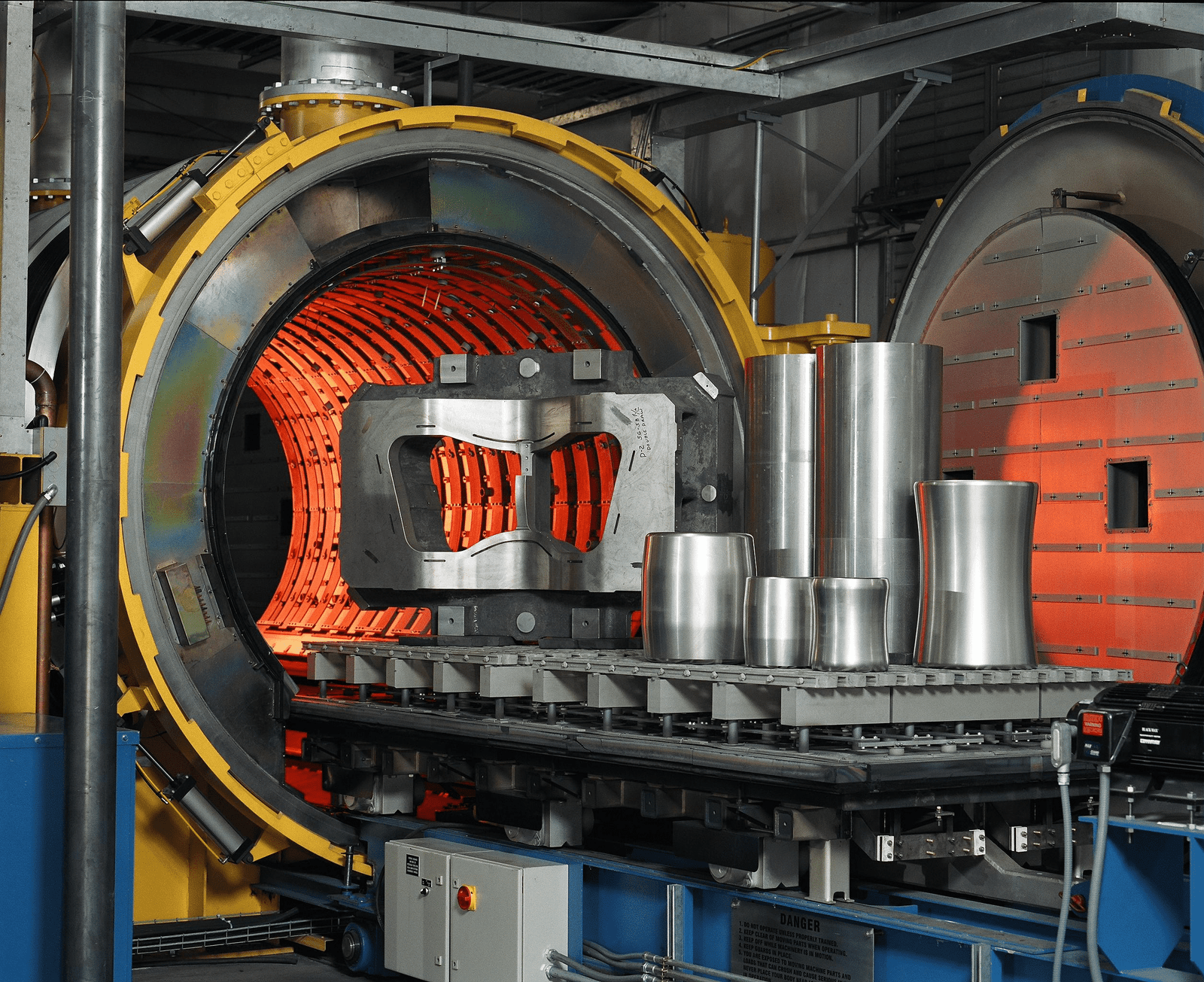
What are the benefits of Heat Treating Processes
The heat treatment offers several benefits, which include:
Improve strength and hardness
The metal’s crystal structure and grain boundary morphology can be modified by controlling the temperature and duration of the heat treatment, leading to improved strength and hardness. This makes the metal more durable and resistant to wear.
Increase toughness and ductility
Proper heat treatment can eliminate internal stresses and defects in the metal, enhancing its toughness and flexibility. This makes it more flexible and easier to work with.
Boost corrosion resistance
Heat treatment carried out under specific temperatures and time conditions can create a dense surface layer, which improves the metal’s corrosion resistance, making it more durable and long-lasting.
Enhance wear resistance
Heat treatment can create special crystal structures that improve the metal’s wear resistance and friction coefficient. This makes it suitable for manufacturing high-strength, high-wear-resistance parts.
Change color and appearance
Some metal materials change in color and surface appearance under certain heat-treating conditions, making them more beautiful and decorative.
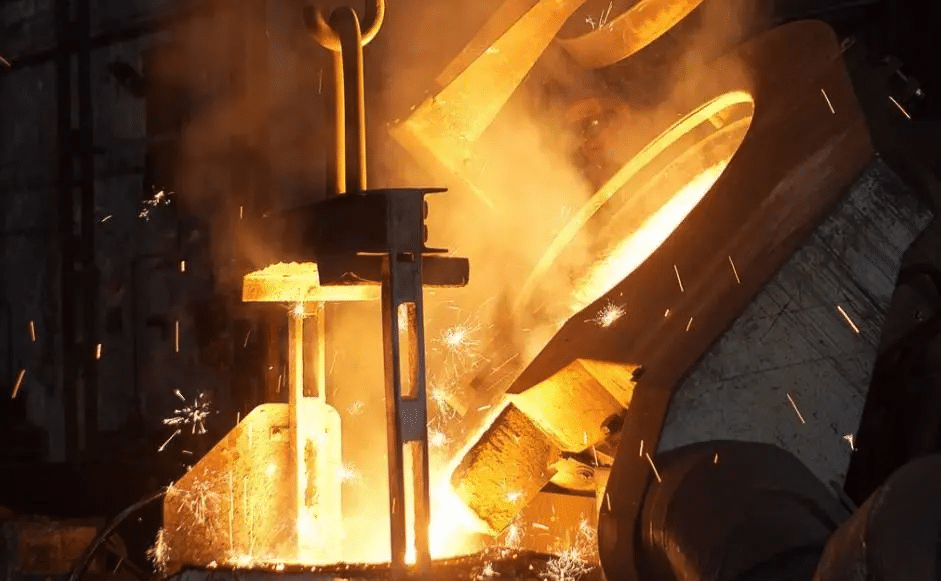
The Disadvantages of Heat Treating Processes and How to Improve
Although the metal heat treatment process can improve the hardness, strength, and corrosion resistance of materials, there are also some potential disadvantages. Let’s explore them and find solutions together.
1. Dimensional variation
Description:
Heat treatment can cause dimensional changes in the machined parts, leading to warping, twisting, or distortion, making the details difficult to assemble or fit with other components.
Solution:
a)Carefully control the heat treatment process’s temperature, time, and cooling rate.
b)In some cases, perform additional machining or finishing operations after heat treatment to achieve the desired dimensions or tolerances.
2. Brittleness increase
Description:
Some materials may become more brittle during the metal heat-treating process, making them more susceptible to cracking or breaking under stress. For example, heat treatment on metals like high-carbon steel may become more brittle, which will be more likely to fracture under impact or heavy loads.
Solution:
a)carefully control the temperature and cooling rate of the process.
b)Some heat-treated materials like High-carbon steel, Martensitic stainless, and Tool steel may benefit from a tempering or annealing step after heat treatment to relieve residual stresses and improve ductility.
3. Residual stress relieving
Description:
During heat treatment, residual stresses may occur in metal alloys, leading to warping, cracking, or distortion. For example, a metal casting heat-treated to improve its strength may have residual stresses that cause it to deform or crack during use.
Solution:
a)Carefully control the temperature and cooling rate of the process.
b)In some cases, stress-relieving heat treatments may be performed after the initial heat treatment to reduce residual stresses and improve dimensional stability.
Easy oxidation
Description:
Some heat-treated metals like titanium alloys oxidize quickly at high temperatures and may form an oxide layer on their surface. The Oxide layer may lead to contamination, reducing the material’s corrosion resistance and mechanical properties.
Solution:
a)Perform the process in a controlled environment with proper ventilation and temperature control.
b)In some cases, additional surface treatments such as pickling, passivation, or coating may be necessary to protect the material from corrosion or contamination.
5 Types of Heat Treatment Process
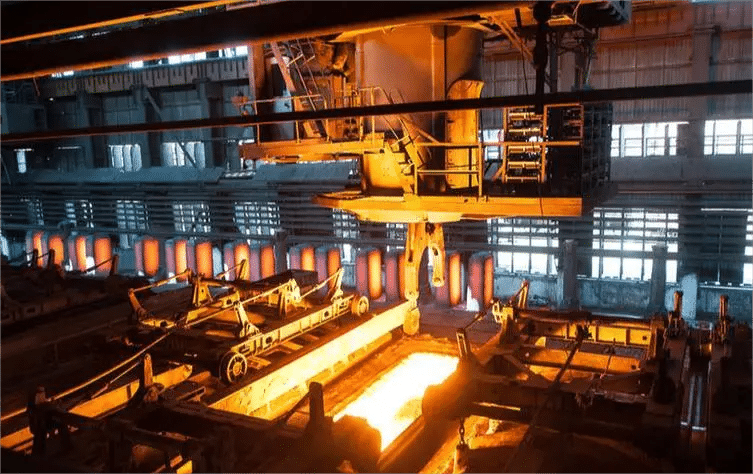
1. Hardening
Hardening is a heat treatment method to make materials more robust and complex by heating them up and quickly cooling them down. This process has three steps: heating, keeping the material at a high temperature, and rapid cooling. Water hardening is the most common method, which produces higher strength and hardness but can also cause the material to deform or crack. Hardening is used in many industries to improve material properties for different purposes.
2. Tempering, Stress Relieving, and Annealing Process
Tempering, stress relieving, and annealing involve heating the material to a specified temperature. They improve a material’s flexibility, toughness, and internal pressure, reducing the risk of deformation and cracking.
Here’s a chart to summarize the differences between tempering, stress relieving, and annealing, along with suggested materials for each treatment:
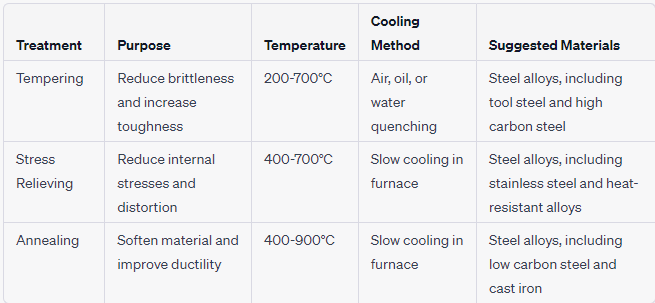
3. Quenching
Quenching is a standard heat treatment method that can make materials harder and more wear-resistant. This heat treatment involves heating the material to a high temperature and then cooling it to change its crystal structure. Water and oil are the most commonly used cooling media. Quenching can be applied to different metal materials, but it may not be suitable for all materials as it can cause deformation or cracking. Careful analysis and testing of the material are necessary to ensure that quenching is feasible and that the desired properties can be obtained.
4 Precipitation Hardening
Precipitation hardening is a heat treatment method that strengthens alloys by creating a deposit within them. First, the alloy is heated to form a solid solution, then quickly cooled to prevent sediment formation. Finally, the alloy is heated to the right temperature to create sediment that improves strength and hardness.
The amount and type of sediment, temperature, and aging time affect the alloy’s strength and hardness. But too much sediment can make it brittle and less tough. Precipitation hardening is commonly used in aluminum, magnesium, titanium, and stainless steel alloys to achieve desired mechanical properties for specific applications.
5. Case Hardening
Case hardening is a heat treatment method that increases the surface hardness of a metal while maintaining its toughness and flexibility. It involves heating the metal and diffusing carbon or nitrogen into the surface layer, creating a more rigid outer layer called the “case.” This is done using techniques like carburizing, nitriding, or carbonitriding. Case hardening is commonly used in manufacturing gears, bearings, and other components that require a hard surface for wear resistance while maintaining strength and toughness in the core.
Here Below is a chart for different types of Case Hardening Processes:
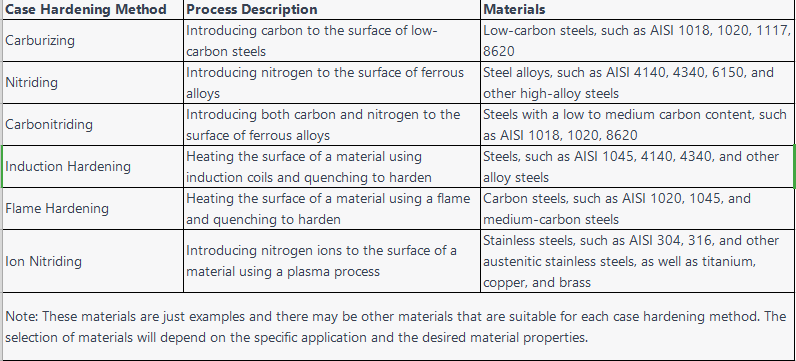
Common Applications of Heat Treatment Processes
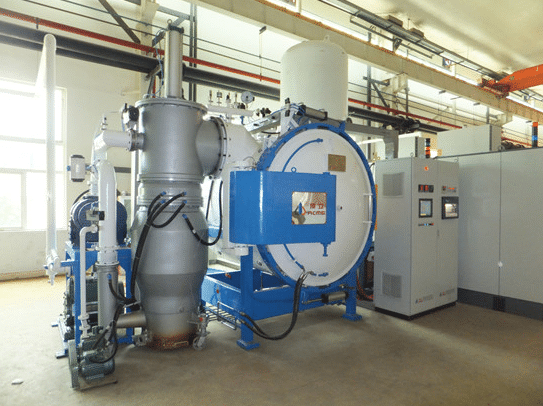
Heat treatment has a wide range of applications in various industries, and the type of heat treatment used depends on the specific requirements of the parts. Here are some examples of how heat treatment is used for different types of parts:
Gears
Gears are subjected to high stresses and wear during operation. Heat treatment processes such as carburizing and quenching can improve their surface hardness and wear resistance, while tempering can increase their toughness and reduce the risk of cracking. Materials commonly used for gears include carbon steel, alloy steel, and stainless steel.
Springs
Springs require good elasticity and fatigue resistance. Heat treatment processes such as oil quenching, tempering, and shot peening can improve their performance. Materials commonly used for springs include high-carbon, alloy, and stainless steel.
Shafts
Shafts are subjected to torsional stresses and bending loads during operation. Heat treatment processes like quenching and tempering can improve strength and fatigue resistance. Materials commonly used for shafts include carbon steel, alloy steel, and stainless steel.
Aircraft components
Aircraft components require high strength, toughness, and corrosion resistance. Heat treatment processes such as solution heat treatment, precipitation hardening, and stress relieving can improve performance. Materials commonly used for aircraft components include aluminum alloys, titanium alloys, and high-strength steel.
Automotive components
Automotive components require high strength, wear resistance, and corrosion resistance. Heat treatment processes such as nitriding, carburizing, and induction hardening can improve surface hardness and wear resistance. Carbon steel, alloy steel, and cast iron are commonly used for automotive components.
How to Determine the Heat Treatment Methods of a CNC Machined Part?

Here’s a flow chart to help you choose the appropriate heat treatment process for designing a CNC machined part:
STEP 1. Determine the material type of your CNC machined part.
STEP 2. Based on the material type, select the appropriate heat treatment method from the following options:
Hardening: Heating the metal to a high temperature, then rapidly cooling it to increase its hardness. This method suits materials like AISI 4140, 4340, and 52100.
Tempering: Heating the metal to a specific temperature and holding it there to reduce its brittleness and increase toughness; suitable for materials like AISI 1040, 1045, and 1095.
Stress relieving: Heating the metal to a specific temperature and holding it there to reduce internal stress that may cause deformation or cracking for brass, copper, and titanium materials.
Annealing: Heating the metal to a specific temperature and holding it there to improve its ductility, machinability, and softness, suitable for materials like carbon steel, brass, and copper.
Quenching: Heating the metal to a high temperature and then rapidly cooling it to increase its hardness and strength. This method suits materials like AISI 4140, 4340, and 52100.
Precipitation hardening: Heating the metal to a specific temperature and holding it there for a period to allow for the formation of tiny, evenly dispersed particles within the material that increase its strength and hardness. It’s for materials like aluminum and stainless steel.
Case hardening: Heating the metal to a specific temperature and then diffusing carbon or nitrogen into its surface to increase its hardness and wear resistance. It is suitable for materials like AISI 8620 and 9310. To decide on the Case hardening process, please go back to the above content, which explains the Case hardening types.
STEP 3. Consider the desired outcome for your CNC machined part. Do you want it to be more challenging, ductile, or wear-resistant?
STEP 4. Select the appropriate heat treatment method based on the material type and desired outcome.
STEP 5. Consult with a heat treatment specialist or refer to industry standards to ensure you use the correct temperature and holding times for the selected heat treatment method.
STEP 6. After the heat treatment, test the CNC machined part to ensure it meets the desired specifications.
Note: The above flow chart is for guidance purposes only. The specific heat treatment process will depend on the size, shape, and complexity of the CNC machined part and the specific material being used.
Forecasting
Heat treatment techniques will continue to be a critical aspect of manufacturing for the foreseeable future. As the demand for higher performance and more durable materials continues to rise, heat treatment processes will play an increasingly important role in achieving these goals. Additionally, as new materials and technologies are developed, there will be a new heat treatment techniques and refine existing ones to meet the changing demands of the industry. The use of computer modeling and simulation will also continue to advance, allowing for more accurate predictions of the effects of heat treatment on materials and the development of more efficient and effective heat treatment processes. Overall, the future of heat treatment looks bright as it continues to play a crucial role in advancing manufacturing technology.
